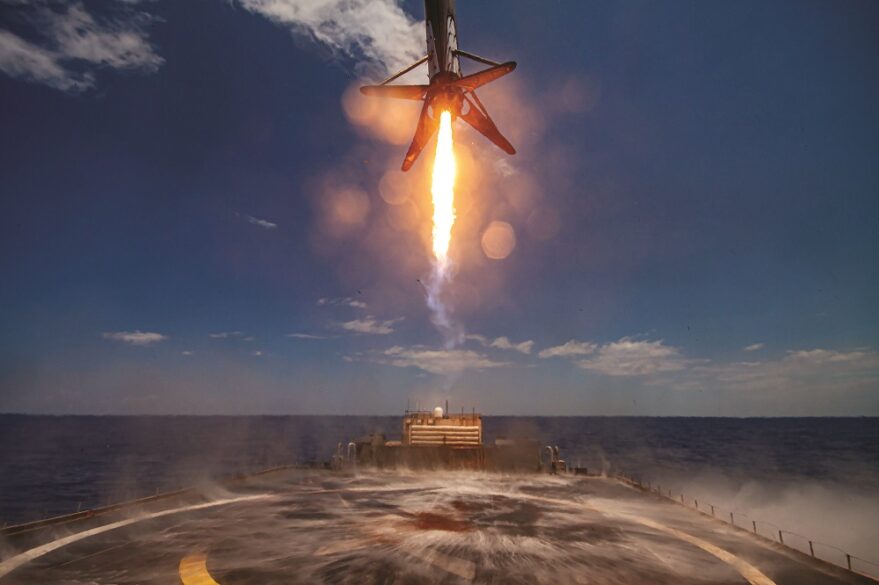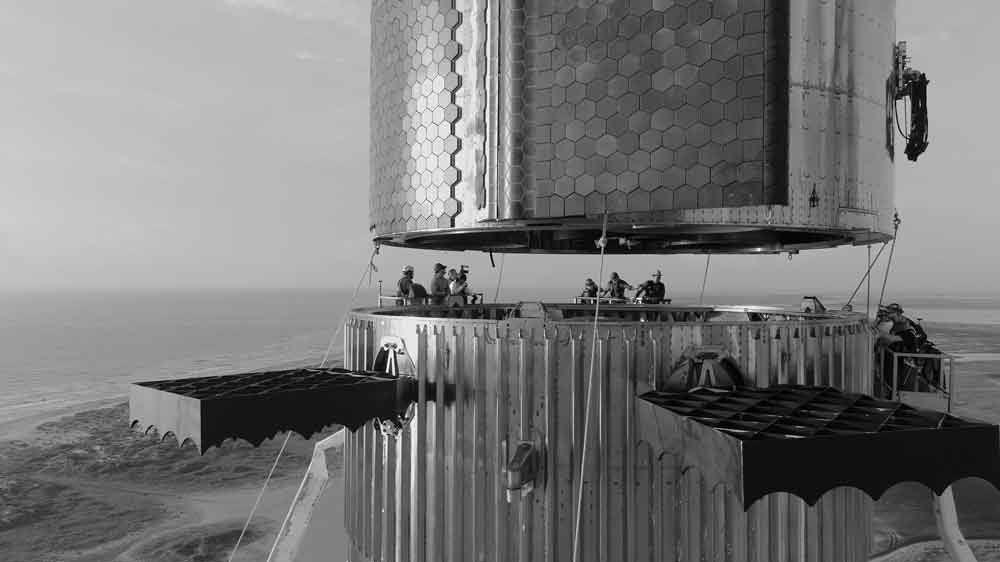Perhaps Elon Musk decided his appearance before the National Academies needed an X factor. When it was time for the SpaceX founder and chief executive to speak at a virtual meeting of the Space Studies Board and Board on Physics and Astronomy on Nov. 17, he appeared on the screen with his youngest son, X (short for X AE A-XII), sitting on his lap. Musk said nothing about why his son was with him, immediately launching a video about SpaceX’s Starship.
X’s appearance was brief — the toddler was whisked away a few minutes later — but he charmed the thousands of people who tuned in to watch. (“Car! Car?” he said when a picture of a Starship vehicle rolling out to the pad appeared. “It’s a rocket on a big car,” Musk said.) Even the world’s richest man must juggle work and family for Zoom meetings.
Whether or not X played any role, Musk got a positive reception from the two committees. What was scheduled to be a half-hour presentation on Starship stretched on for more than an hour, as the scientists and engineers on the panels peppered him with questions ranging from technical details on the design of Starship to almost philosophical ones about the threats facing humanity. He spent 10 minutes alone answering one question about the use of stainless steel in Starship’s design: “Obviously, you can tell I’m a huge fan of stainless steel.”
The lack of sharply critical questions, about Starship or SpaceX, suggests Musk won over the committees. SpaceX has legions of fans worldwide cheering every minor development. And yet, at times, it can seem like the whole world is taking on SpaceX as the company expands from launch vehicles to satellite broadband to lunar landers.
GROWING COMPETITION
The scope of SpaceX’s competition has grown with its ambitions. When the company started nearly 20 years ago, it focused on small launch, pitting the Falcon 1 against other small launch vehicle developers, including Russian companies marketing converted ICBMs. The medium-lift Falcon 9 aimed at larger commercial and government customers, putting SpaceX into fierce competition with United Launch Alliance for U.S. government business and Arianespace for commercial contracts.
Today, it’s hard to imagine a launch company that does not consider itself a competitor to SpaceX. Even the small launch vehicle industry watches SpaceX warily: while SpaceX long ago abandoned the Falcon 1, its rideshare services on Falcon 9 offer smallsats far lower prices to get to orbit than dedicated small launchers. Those companies now have to explain how their vehicles, if not cheaper than SpaceX’s rideshare services, can offer a quality of service that justifies a premium price.

SpaceX’s move into satellite broadband with Starlink opened up a second front of global competition. It now competes with conventional geostationary satellite operators and companies such as Amazon, OneWeb, and Telesat proposing rival satellite constellations. While those systems are still in development, the competition has played out in filings before the U.S. Federal Communications Commission, where Starlink rivals have often vociferously sought to block efforts by SpaceX to modify its license, with SpaceX countering with equal vigor.
That competition creates thorny conflicts for companies that might be open to doing business with SpaceX as a launch provider if it didn’t mean supporting a company developing a competing constellation. SpaceX, at least publicly, says it has no problem launching satellites for Starlink competitors.
But those companies have, for now, found alternatives, likely at higher costs than Falcon 9. OneWeb is using Soyuz rockets to launch its constellation while Amazon’s Project Kuiper will start deploying its satellites using some of the last Atlas 5 rockets ULA flies before retiring the vehicle in favor of Vulcan Centaur.
NASA’s selection of SpaceX’s Starship as the basis of the lunar lander that will transport Artemis astronauts to the moon created yet another arena for competition. Both Blue Origin and Dynetics filed protests with the U.S. Government Accountability Office when NASA selected SpaceX (and only SpaceX) for the Human Landing System (HLS) program. The GAO rejected both protests.
Blue Origin then filed suit in the Court of Federal Claims. A Blue Origin executive said that NASA’s treatment of SpaceX’s flight readiness reviews, a key point of contention in the suit, presented “serious safety issues” and put it at a disadvantage.
The court dismissed the suit Nov. 4, concluding that Blue Origin had no standing in the case and, even if it had, it would have lost on the merits. Blue Origin conceded and SpaceX was finally able to start its HLS work with NASA.
ENEMY OF SOME PEOPLE
It’s not just other businesses that are doing battle with SpaceX. When SpaceX launched its first batch of Starlink satellites in May 2019, astronomers were startled by how bright the train of satellites appeared in the night sky. With SpaceX planning tens of thousands of satellites, the company soon became public enemy No. 1 to astronomers, who feared the satellites would ruin their research.
Two years and 1,800 satellites later, many astronomers still complain about Starlink, but others acknowledge that the company has taken some steps to mitigate the problem, making changes to its satellites to reduce the light they reflect. It hasn’t completely resolved the problem, particularly for sensitive instruments at major observatories, but it kept the problem from getting worse.
SpaceX’s willingness to cooperate has been welcomed by astronomers. “SpaceX has been a role model for other companies” developing constellations, said Connie Walker of the National Science Foundation’s National Optical-Infrared Astronomy Research Laboratory, one of the leaders in efforts to study the effect of satellite constellations on astronomy.
In Texas, SpaceX’s plans to launch its Starship from Boca Chica face opposition from residents. Environmentalists worry about the effect launches, and launch failures, will have on endangered species and other wildlife along the Gulf of Mexico coast. They raised their concerns at two public meetings in October held by the Federal Aviation Administration about an environmental assessment of SpaceX’s launch plans there, calling for a more rigorous environmental impact statement.
“The stakes are simply too high not to invest in a thorough EIS,” said Sharon Wilcox, senior Texas representative for one environmental group, Defenders of Wildlife, at one of the public meetings.
SpaceX’s investment in the region has also generated opposition from residents who fear the company is driving up housing costs and changing the nature of the community. “SpaceX is just something that is directly destructive and another example of colonization of our community that we just don’t need,” said one activist, Rebekah Hinojosa.
However, those public hearings included many people, both locals and those participating from across the country, singing the praises of SpaceX and calling on the FAA to allow the company to proceed with Starship orbital launches. In mid-November, the FAA said it expects to complete its environmental assessment by the end of the year. Musk, at the National Academies meeting, said he expected to get an FAA launch license at that time and be ready for orbital launches as soon as January.
“THEY DON’T PLAY WELL WITH OTHERS”
It’s not uncommon for large aerospace companies with a wide range of products to deal with many potential competitors and other critics. Why, though, does it feel different with SpaceX?
One reason is that SpaceX often goes it alone on major projects rather than partnering with other companies. “They don’t play well with others,” said one industry official, speaking on background, concluding the ability to go quickly on its own outweighs any benefits of joining forces.
In aerospace, shifting allegiances are common: two companies may be competitors on one program but partners on another. For NASA’s HLS program, for example, Blue Origin partnered with Lockheed Martin and Northrop Grumman. At the same time, Dynetics led another team whose partners included Sierra Nevada Corp.’s space division, now called Sierra Space. But for the agency’s effort to develop commercial space stations, Blue Origin went with Boeing and Sierra Space, while Northrop and Dynetics partnered on a separate concept, and Lockheed turned to Nanoracks and its corporate parent, Voyager Space, for a third proposal.
SpaceX, by contrast, went it alone on HLS, and won. It did not disclose if it bid on NASA’s commercial space station program, although only the Blue Origin, Lockheed and Northrop teams won $415 million in contract awards NASA announced Dec. 2.
It’s hard to criticize SpaceX’s go-it-alone approach, though, given the successes the company has racked up. Falcon 9, with its reusable first stage, is launching more often than any other rocket, flying 26 times in 2020 and 27 times through early December 2021. SpaceX is launching not only more often than any other company, it’s beating every country but China. Starlink is up and running, serving 140,000 users across 20 countries with an additional 750,000 preorders worldwide. Crew Dragon is transporting NASA and commercial astronauts to orbit, launching five crewed missions since May 2020, while Boeing is still struggling to achieve a successful uncrewed test of its rival capsule. Starship beat all comers to win a contract to develop a lander to carry astronauts to the surface of the moon. “It’s working for them,” that industry official acknowledged.
SpaceX’s biggest threat to its plans might be itself. The company requires billions of dollars of capital to develop Starship and build out Starlink, whose next generation of satellites will rely on Starship for launch. Problems increasing production of the Raptor engines on Starship led Musk to send an email to SpaceX employees on Black Friday, warning that “we face genuine risk of bankruptcy” if SpaceX can’t launch Starship at a rate of once every two weeks next year. Musk, in later tweets, backed off that threat, saying bankruptcy was “unlikely” but not impossible.
The other big threat is the clock, because Musk is in a hurry. At the National Academies meeting, he reiterated his long-stated desire to make humanity multiplanetary, starting with Mars. “The window of this opportunity is open now for the first time in the four-and-a-half-billion-year history of Earth. It may be open for a long time or it may be open for only a short time,” he said. “I think we should be hasty just in case it’s open for a short time.”
This article originally appeared in the December 2021 issue of SpaceNews magazine.
